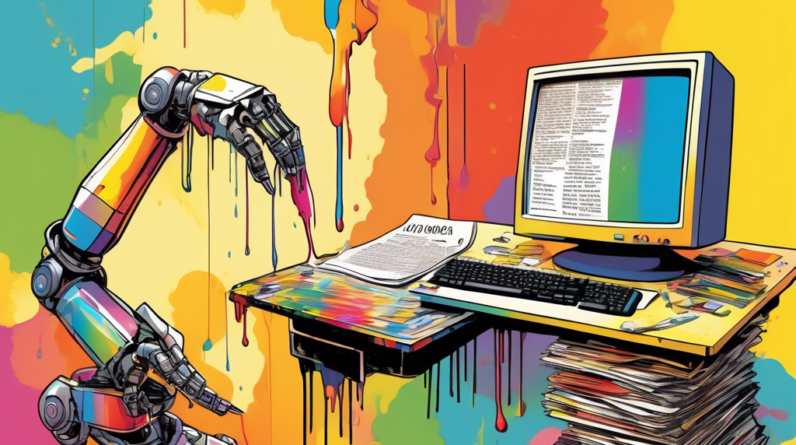
TUAW Rises From the Ashes, But Not Without Controversy
Allegations of Plagiarism and AI-Generated Content Cast a Shadow on the Tech Site’s Return
The tech world was abuzz with a mix of nostalgia and skepticism as TUAW, the once-popular Apple-focused blog, announced its return after a six-year hiatus. However, the excitement was short-lived as allegations of plagiarism and the use of AI-generated content quickly surfaced, tarnishing the site’s comeback and sparking a heated debate about journalistic integrity in the digital age.
A Blast from the Past Marred by Familiar Issues
Launched in 2004, TUAW, short for The Unofficial Apple Weblog, gained a loyal following for its timely news, insightful reviews, and passionate community discussions. The site was a go-to source for Apple enthusiasts, rivaling the likes of MacRumors and 9to5Mac in its heyday. However, TUAW’s star began to fade in the mid-2010s, facing challenges like increased competition and a changing media landscape. In 2017, AOL, TUAW’s then-parent company, decided to shut down the site, leaving a void in the Apple blogging sphere.
Fast forward to 2023, and TUAW made an unexpected reappearance, promising a fresh start and a renewed commitment to delivering high-quality Apple coverage. But the initial wave of goodwill quickly evaporated as eagle-eyed readers and industry watchdogs began to notice glaring similarities between TUAW’s new content and articles published on other websites. Accusations of plagiarism spread like wildfire across social media, with screenshots and side-by-side comparisons highlighting instances of verbatim copying and unattributed use of original reporting.
Stolen Graphics and the Rise of AI-Generated Content
Adding fuel to the fire were discoveries that TUAW was not only allegedly plagiarizing text but also using images without permission. Reports emerged of photographers and graphic designers finding their work, often watermarked, displayed on the site without any attribution or licensing agreement. The unauthorized use of visuals further damaged TUAW’s credibility and raised serious concerns about copyright infringement.
Further investigation revealed another layer to the controversy: the potential use of AI-generated content. While the use of AI writing tools is not inherently unethical, the way TUAW allegedly employed them raised red flags. Critics pointed to articles with stilted language, factual inaccuracies, and a lack of original analysis—hallmarks of poorly implemented AI-generated content. This raised concerns about the site prioritizing quantity over quality and potentially misleading readers with unverified or fabricated information.
The Fallout and the Future of TUAW
The backlash against TUAW’s alleged plagiarism and use of AI was swift and severe. Social media platforms were flooded with criticism, with many former readers expressing disappointment and outrage. Industry experts weighed in, condemning the site’s practices and highlighting the importance of ethical journalism in a time when misinformation is rampant. The controversy even caught the attention of major tech publications, which published articles scrutinizing TUAW’s actions and questioning the site’s future.
As of now, TUAW has yet to issue a formal statement addressing the allegations. The site remains active, but its reputation has undoubtedly suffered a significant blow. The controversy serves as a stark reminder of the ethical pitfalls that can plague online publishing, particularly in an era of readily available AI tools.
Key Takeaways from the TUAW Controversy
The TUAW saga offers several valuable lessons for content creators, publishers, and consumers of online information:
1. The Importance of Originality and Attribution
The allegations against TUAW underscore the paramount importance of originality and proper attribution in online content creation. Plagiarism, whether intentional or unintentional, is a serious offense that can have severe consequences for individuals and organizations. Content creators must understand the importance of producing original work and properly citing sources when referencing the work of others.
2. The Ethical Use of AI in Content Creation
The TUAW controversy also highlights the ethical considerations surrounding the use of AI in content creation. While AI writing tools can be valuable assets for writers, they should be used responsibly and ethically. Content creators must ensure that AI-generated content is factually accurate, free of plagiarism, and clearly identified as such to avoid misleading readers.
3. The Need for Critical Media Literacy
The TUAW situation underscores the importance of critical media literacy in today’s digital landscape. Consumers of online information must be vigilant in verifying the credibility of sources and critically evaluating the content they consume. Cross-referencing information, looking for signs of plagiarism, and being wary of overly promotional or sensationalized content are essential skills in the fight against misinformation.
The Future of Tech Journalism in the Age of AI
The controversy surrounding TUAW’s return raises important questions about the future of tech journalism in the age of AI. As AI writing tools become increasingly sophisticated, the lines between human-generated and AI-generated content are likely to become increasingly blurred. This presents both challenges and opportunities for the journalism industry.
On the one hand, AI has the potential to revolutionize journalism by automating tasks, enhancing efficiency, and providing journalists with more time to focus on in-depth reporting and analysis. On the other hand, the rise of AI-generated content raises concerns about job displacement, the spread of misinformation, and the potential erosion of trust in traditional media.
Ultimately, the future of tech journalism will depend on how effectively the industry adapts to the rise of AI. By embracing ethical guidelines for AI use, prioritizing transparency and accuracy, and focusing on human-centric storytelling, tech publications can leverage the power of AI while upholding the core principles of journalism.
A Wake-Up Call for the Industry
The allegations against TUAW serve as a stark reminder of the importance of ethical content creation in the digital age. As technology continues to evolve, it is crucial for content creators, publishers, and technology platforms to work together to establish clear guidelines and ethical frameworks for the use of AI in content creation. By prioritizing transparency, accuracy, and originality, we can ensure that the internet remains a valuable source of information and a platform for genuine human connection.




